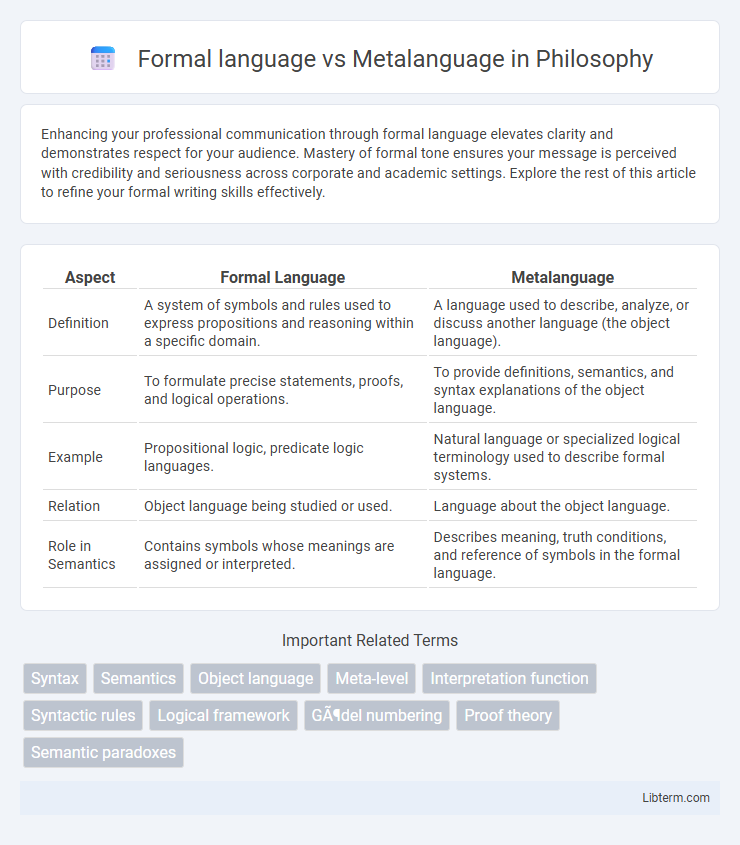Enhancing your professional communication through formal language elevates clarity and demonstrates respect for your audience. Mastery of formal tone ensures your message is perceived with credibility and seriousness across corporate and academic settings. Explore the rest of this article to refine your formal writing skills effectively.
Table of Comparison
| Aspect | Formal Language | Metalanguage |
|---|---|---|
| Definition | A system of symbols and rules used to express propositions and reasoning within a specific domain. | A language used to describe, analyze, or discuss another language (the object language). |
| Purpose | To formulate precise statements, proofs, and logical operations. | To provide definitions, semantics, and syntax explanations of the object language. |
| Example | Propositional logic, predicate logic languages. | Natural language or specialized logical terminology used to describe formal systems. |
| Relation | Object language being studied or used. | Language about the object language. |
| Role in Semantics | Contains symbols whose meanings are assigned or interpreted. | Describes meaning, truth conditions, and reference of symbols in the formal language. |
Introduction to Formal Language and Metalanguage
Formal language consists of precisely defined symbols and rules used to create strings or expressions within mathematics, computer science, and logic. Metalanguage is the language used to describe, analyze, and manipulate formal languages, providing a framework for defining syntax, semantics, and grammar. Understanding metalanguage is essential for interpreting formal languages and constructing formal systems with clear semantic meaning.
Definitions: What is a Formal Language?
A formal language is a set of strings constructed from a finite alphabet according to specific syntactic rules or grammar, used primarily in mathematics, computer science, and logic for precise communication and problem-solving. It avoids ambiguity by having well-defined formation rules that determine which sequences of symbols are valid statements or expressions. Unlike natural languages, formal languages rely on strict structural criteria to enable formal reasoning, automated processing, and verification.
Understanding Metalanguage: Key Concepts
Metalanguage is a system of symbols and terms used to describe, analyze, or discuss another language, known as the object language, enabling precise communication about linguistic structures and meanings. It includes syntactic categories, semantic roles, and operational rules that provide a framework for formal analysis and interpretation of language elements. Understanding metalanguage enhances clarity in linguistic theory, programming languages, logic, and computer science by establishing a clear, standardized vocabulary to discuss language features and transformations.
Historical Context and Evolution
Formal language originated in the early 20th century with the development of symbolic logic and the need for precise mathematical communication, marked by figures such as Frege and Russell. Metalanguage emerged concurrently as a tool to describe and analyze formal languages, enabling clarity in semantics and syntax through layers of language about language. Over time, both formal language and metalanguage evolved to shape foundational theories in computer science, linguistics, and logic, influencing programming languages and artificial intelligence development.
Structural Differences Between Formal Language and Metalanguage
Formal language consists of strictly defined symbols and syntactic rules used to construct valid expressions within a system, emphasizing object-level communication. Metalanguage, by contrast, is a higher-level language designed to describe, analyze, and manipulate the formal language, including its syntax and semantics. Structurally, formal language operates within the system's grammar, whereas metalanguage incorporates additional vocabulary and rules to reference and explain those grammatical elements.
Applications in Linguistics and Computer Science
Formal language serves as a structured system of symbols and rules used primarily in computer science for programming languages, automata theory, and compiler design, enabling precise communication with machines. Metalanguage, in contrast, functions as a language used to describe, analyze, or manipulate other languages, crucial in linguistics for grammar specification, syntax analysis, and semantic frameworks. The application of formal languages supports algorithmic processing and language recognition tasks, while metalanguage facilitates linguistic theory development and the creation of language description tools such as Backus-Naur Form (BNF).
Role in Mathematical Logic and Programming
Formal language serves as the foundational structure in mathematical logic and programming by providing precise syntax and semantics for expressing propositions, algorithms, and proofs. Metalanguage functions as the language used to describe, analyze, and reason about formal languages, enabling the formulation of grammar rules, type systems, and semantic frameworks. The interplay between formal language and metalanguage is essential for defining programming language constructs, verifying program correctness, and developing automated theorem provers.
Examples Illustrating Formal Language and Metalanguage
Formal language examples include mathematical logic expressions, such as propositional formulas like (P Q) - R, and programming languages like Python or JavaScript, used to encode precise instructions. Metalanguage examples involve linguistic descriptions, such as the use of Backus-Naur Form (BNF) to define the grammar of programming languages or the use of terms like "noun" and "verb" to describe categories in English syntax. These examples illustrate how formal languages function within strict symbolic systems while metalanguages provide the tools to describe and analyze those systems.
Advantages and Limitations of Each
Formal language offers precise syntax and unambiguous rules essential for programming and mathematical logic, ensuring consistent interpretation and machine readability. Metalanguage provides a framework to describe and analyze formal languages, enhancing understanding and facilitating language development but often lacks the strictness required for automated processing. While formal language excels in rigorous applications, it can be rigid; metalanguage, though flexible and explanatory, may introduce ambiguity and complexity in formal system design.
Conclusion: Choosing Between Formal Language and Metalanguage
Selecting between formal language and metalanguage depends on the specific communicative context and analytical purpose. Formal language facilitates precise, unambiguous representation of concepts through strict syntactic rules, making it ideal for mathematical proofs, programming, and logic formulation. Metalanguage enables explanation and analysis of object languages, providing a higher-level perspective necessary for linguistics, language theory, and semantic evaluations.
Formal language Infographic

 libterm.com
libterm.com